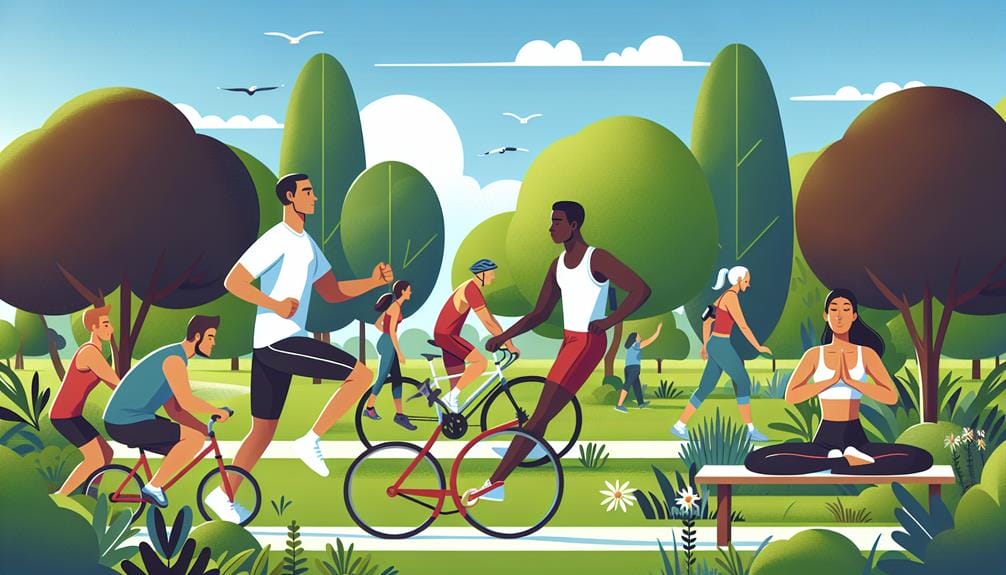To stand tall and confident, start with exercises like the Child's Pose to stretch your back and the Shoulder Blade Squeeze to align your upper body. Include the Bridge Exercise to engage your core, the Chin Tuck to correct forward head posture, and the Wall Angel to improve upper back flexibility. Consistently practicing these moves will help align your head, shoulders, and hips, reducing slouching and discomfort. Use minimal equipment like a yoga mat, resistance bands, and an exercise ball to enhance your routine. For detailed instructions and more tips, continue exploring further techniques and exercises.
Key Takeaways
- Perform Child's Pose daily to stretch and relax back muscles, improving overall posture.
- Regularly do Shoulder Blade Squeezes to enhance upper body alignment and reduce shoulder tension.
- Incorporate Spine Mobility Drills to counteract rounded shoulders and increase upper back flexibility.
- Practice Bridge Exercise to strengthen core and glutes, promoting a straight and sturdy posture.
- Use Chin Tucks to correct forward head posture and strengthen neck muscles for better cervical alignment.
Understanding Current Posture
To understand your current posture, stand against a wall and check if your head, shoulders, and hips touch it. If they don't, you might be a modern-day Quasimodo. Look for signs of slouching like rounded shoulders, forward head position, or excessive arching in the lower back.
Feel any neck or back pain? That's your body screaming for help! Before you start any exercises, note where you feel tension or discomfort in your shoulders or back. Stand tall and have someone snap a quick pic of your natural stance.
A professional, like a physiotherapist, can provide a detailed analysis. Understanding your posture is the first step to fixing it and standing tall like the confident person you are!
Setting Goals

Regularly setting specific posture improvement goals can greatly help track your progress and keep you motivated.
You don't have to become a posture perfectionist overnight. Instead, focus on creating realistic goals.
Here's how you can set yourself up for success:
- Identify Your Stumbling Blocks: Are you slouching, or is your core feeling weaker than a wet noodle?
- Set Specific Goals: Aim for measurable targets like reducing slouching or strengthening core muscles.
- Consistent Practice: Make posture exercises a daily habit, like brushing your teeth—but way more exciting!
- Consult a Physical Therapist: They can tailor goals to your individual needs, ensuring you're not biting off more than you can chew.
Stick to these tips, and you'll be standing tall in no time!
Necessary Equipment
You'll need some basic equipment to get started on your posture improvement journey. First, grab a yoga mat for comfort during those floor exercises. Next, resistance bands are your new best friends; they'll help add intensity. An exercise ball is fantastic for working your core muscles and balance. For extra fun, try a stability ball chair or a posture corrector device to keep you aligned while sitting. Finally, don't forget those trusty dumbbells for strength-building exercises.
| Equipment | Purpose |
|---|---|
| Yoga Mat | Comfort and stability during floor exercises |
| Resistance Bands | Adds intensity and resistance |
| Exercise Ball | Strengthens core muscles and improves balance |
| Stability Ball Chair | Promotes proper alignment while sitting |
| Posture Corrector Device | Provides additional support |
| Dumbbells | Increases challenge and effectiveness |
With these tools, you'll be standing tall and confident in no time!
Child's Pose

Child's Pose is a yoga stretch that helps lengthen and align your spine, improving posture over time. Not only does it help counteract those pesky rounded shoulders, but it also strengthens your back muscles. Plus, it opens up your chest, making you feel like you can conquer the world—or at least a slouch-free day.
Here's how to improve your posture with Child's Pose:
- Kneel on the floor: Sit back on your heels, and stretch your arms forward.
- Lower your chest: Bring it towards the floor, between your knees.
- Relax your back muscles: Let them release tension as you breathe deeply.
- Hold the position: Stay for 30 seconds to a minute.
Try it daily for posture perfection!
Shoulder Blade Squeeze
The shoulder blade squeeze is a simple yet powerful exercise to enhance your posture and alleviate shoulder tension. Picture yourself squeezing a pencil between your shoulder blades—yes, it's as fun as it sounds! This move targets those muscles that are often overlooked but essential for improving posture and shoulder stability.
By regularly performing shoulder blade squeezes, you'll notice better upper body alignment and reduced postural issues. Plus, your shoulders will thank you for the tension relief. So, stand tall, imagine that invisible pencil, and give those muscles a good squeeze.
It's a tiny move with big benefits, setting you on the path to a more confident, upright posture.
Chest Opener Stretch

To perform the Chest Opener Stretch, stand tall with your feet shoulder-width apart, clasp your hands behind your back, and gently lift your arms while squeezing your shoulder blades together.
This technique helps counteract the effects of hunching over by stretching the chest muscles and opening up the front of your body.
Incorporating this stretch into your routine can alleviate upper back and neck pain, enhance breathing, and promote a more upright posture.
Stretching Technique Steps
Start by standing tall with your feet shoulder-width apart and your arms relaxed at your sides. Ready to improve your posture and feel like a superhero? Let's delve into the Chest Opener Stretch, which enhances shoulder mobility and helps correct rounded shoulders.
Follow these steps to relieve upper body tension and enhance body awareness:
- Clasp your hands behind your back. If you can't, grab a towel.
- Straighten your arms while gently pulling your shoulder blades together.
- Lift your chest upward and hold for 20-30 seconds, breathing deeply.
- Slowly release and return to the starting position.
This stretch will transform you from the Hunchback of Notre-Dame to a posture pro in no time!
Benefits for Posture
Regularly doing the chest opener stretch greatly improves your posture by counteracting slouching and rounded shoulders. Imagine standing tall and looking like a superhero instead of a hunched-over desk jockey.
This stretch works wonders by loosening tight chest muscles and opening up the front of your body. As a result, you'll naturally adopt a more upright posture, making you look and feel more confident. Plus, with improved breathing capacity and lung function, you'll not only stand tall but breathe easier too.
Incorporate the chest opener stretch into your daily routine, and you'll soon notice a more confident appearance and less tension in your chest and shoulders. Embrace the stretch and stand tall!
Cat-Cow Stretch
Participating in the Cat-Cow stretch can greatly improve your spine's flexibility and promote proper alignment. This gentle yoga exercise is your ticket to transforming your back from a slouchy mess to a majestic pillar of strength.
The Cat-Cow stretch engages the muscles along your spine, helping to improve posture and minimize tension in the upper back and shoulder blades. Here's how to do it:
- Start on all fours: Align your wrists under your shoulders and knees under your hips.
- Arch your back (Cow): Drop your belly, lift your head, and stretch your spine.
- Round your back (Cat): Tuck your tailbone, pull your belly button towards your spine, and drop your head.
- Repeat: Alternate between Cow and Cat for a few minutes.
You'll feel the benefits in no time!
Thoracic Extension
To improve your posture, focus on thoracic extension exercises that enhance chest opening and spine mobility. Techniques like chest opening drills help counteract the effects of sitting and slouching.
Spine mobility exercises guarantee your thoracic spine moves freely, supporting better overall alignment.
Chest Opening Techniques
Incorporating chest opening techniques, such as thoracic extension exercises, can dramatically improve your posture by alleviating stiffness in the upper back. Let's be real—no one wants to look like a human question mark. These exercises are your secret weapon against rounded shoulders and poor upper body alignment. Plus, they can boost your mobility. Here's how to get started:
- Foam Roller Extensions: Lie on a foam roller placed horizontally under your upper back and gently arch over it.
- Wall Angels: Stand against a wall, sliding your arms up and down like you're making a snow angel.
- Cat-Cow Stretches: Alternate between arching and rounding your back on all fours to loosen things up.
- Doorway Stretch: Place your arms on either side of a doorway and lean forward to open up the chest.
You'll be standing tall and confident in no time!
Spine Mobility Drills
Working on thoracic extension drills can greatly enhance the flexibility and mobility of your upper back. Imagine your thoracic spine as a rusty hinge—these exercises are the oil it desperately needs. They help counteract those pesky rounded shoulders from hours hunched over your phone or desk.
By improving your thoracic spine's mobility and flexibility, you'll stand taller and look more confident. Think of it as giving your upper back a well-deserved spa day. These drills not only improve posture but also alleviate stiffness and discomfort.
Bridge Exercise
The bridge exercise effectively targets your core, glutes, and lower back muscles to enhance posture and stability. To perform it, lie on your back, bend your knees, and keep your feet flat on the floor. Engage your core and lift your hips until your body forms a straight line from shoulders to knees. Hold for a few seconds, then lower back down.
Here's a quick guide:
- Lie down: On your back, knees bent, feet flat.
- Engage: Tighten your core and glutes.
- Lift: Raise your hips to create a straight line.
- Hold: Maintain the position, then lower.
Incorporating bridges into your routine can transform your posture from slouchy to statuesque. Plus, your lower back will thank you!
Chin Tuck

After strengthening your core and lower back with bridges, it's time to focus on your neck alignment with the Chin Tuck exercise. If you're tired of your head leading the way like an over-eager puppy, this one's for you. The Chin Tuck helps correct that forward head posture, aligning your head over your shoulders—where it belongs.
By strengthening your neck muscles and improving cervical spine alignment, you'll not only alleviate neck pain but also stand taller and more confidently. It's a simple exercise you can do anytime, anywhere. Just gently tuck your chin towards your chest, hold for a few seconds, and release.
Regular practice will improve your posture and reduce neck strain.
Wall Angel
To perform Wall Angels correctly, stand with your back against a wall, ensuring your lower back, shoulders, and head remain in contact.
Raise your arms to form a 'W' shape, then slowly extend them upward, keeping elbows and wrists touching the wall.
Avoid arching your back or letting your arms drift away from the wall to maximize the effectiveness of this exercise.
Proper Form Techniques
Start by standing with your back flat against a wall and your feet a few inches away from it. Your lower back should also be flat on the wall.
Follow these steps for proper form:
- Press into your hands: Place your hands behind your back, palms facing the wall, and press into them.
- Maintaining good posture: Keep your shoulder blades together and down, as if you're trying to tuck them into your back pockets.
- Move your arms: Slowly raise your arms above your head, keeping them in contact with the wall. Focus on posture correction.
- Feet flat on the floor: Make sure your feet remain flat on the floor throughout the movement.
These techniques will help you stand tall and confident!
Common Mistakes Avoided
While mastering proper form techniques is essential, it's equally important to recognize and avoid common mistakes when performing Wall Angels.
First, don't let your lower back arch too much; keep it flat against the wall to maintain proper alignment.
Second, avoid shrugging your shoulders toward your ears—this defeats the purpose of improving your posture. Your shoulder blades should move smoothly along your upper back.
Lastly, make sure your chest stays open and don't let it cave in.
If you skip these critical points, you won't reap the full benefits of improved shoulder mobility, upper back strength, and chest opening. Remember, correct form is key to enhancing posture and achieving that tall, confident stance you're aiming for!
High Plank
Incorporating the High Plank into your fitness routine can greatly enhance your posture by strengthening your core muscles. This core-strengthening exercise will help you engage abdominal muscles, support your spine, and maintain proper alignment. Plus, you'll look like a fitness pro while improving your overall posture.
Here's how to make the High Plank work for you:
- Engage abdominal muscles: Keep those abs tight to support your spine.
- Maintain proper alignment: Your body should form a straight line from head to heels.
- Enhance balance and flexibility: This exercise challenges your stability.
- Improve overall posture: Regular practice guarantees you stand tall and confident, avoiding the dreaded slouch.
Get ready to plank your way to perfect posture!
Conclusion
By incorporating these exercises into your routine, you'll transform your posture from slouchy to superhero in no time.
Start with understanding your current posture, set achievable goals, and gather any necessary equipment.
Practice Child's Pose, Shoulder Blade Squeeze, Bridge Exercise, Chin Tuck, Wall Angel, and High Plank consistently.
With dedication, you'll not only stand taller but also feel more confident and energized.
Your journey to impeccable posture starts now—commit and see the incredible results!









Leave a Comment